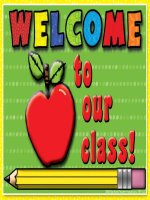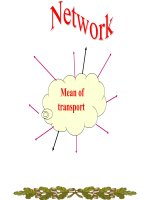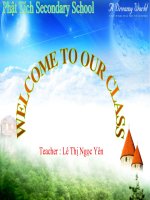Unit 10. Our houses in the future. Lesson 5. Skills 1
Bạn đang xem bản rút gọn của tài liệu. Xem và tải ngay bản đầy đủ của tài liệu tại đây (123.36 KB, 5 trang )
<span class='text_page_counter'>(1)</span><div class='page_container' data-page=1>
<i><b>Period: 82</b></i>
<b>Unit 10: OUR HOUSES IN THE FUTURE</b>
<b>SKILLS 1</b>
<b>I. Objectives</b>
<i><b>1. Knowledge, Skills, Attitude: </b></i>
<i><b>a. Knowledge: By the end of this lesson, students can read for specific information about future houses </b></i>
and appliances; Talk about houses in the future (type, location, surroundings, appliances)
<i><b>- Vocabulary: the lexical items related to “Our houses in the future”.</b></i>
<i><b>- Grammar: Will + V for the future and might + V for future possibility</b></i>
<i><b>b. Skills: listening, speaking, reading and writing.</b></i>
<i><b>c. Attitude: - Students love their houses.</b></i>
<i><b>2. Capacity is formed and developed for students</b></i>
- Self – learning capability
- Communicative competence
<b>II. Preparation</b>
<i><b>1. Teacher: text book, extra board, cassette tape and real objects.</b></i>
<i><b>2. Students: textbook, notebook, workbook.</b></i>
<b>III. Students’ activities</b>
1. Warm up (5’)
<b>Sts’ and T’s activities</b> <b>Contents</b>
- Call 2 Ss to tell about the appliances in the future.
- Correct some and give mark.
S1: washing machine
smart clock
<i><b>2. Knowledge formation activities (36’)</b></i>
<b>Sts’ and T’s activities</b> <b>Contents</b>
T: Asks Ss to look at the picture first. Encourages
Ss to get the details of the picture (type of house,
location, surroundings and appliances). Then tells
Ss to work in pairs, asking and answering the
questions provided.
Ss: Discuss in pairs.
T: Calls on some Ss to give their answers.
Ss: Give their answers before the class.
T: Gives feedback - Corrects
<b>Reading. </b>
<b>1. Look at the pictures and discuss with the </b>
<b>partner.</b>
<b> *Suggested:</b>
<i> 1. What type of house do you think it is? (It’s a </i>
<i>villa)</i>
<i> 2. Where do you think the house is? (On the ocean)</i>
<i> 3. What you can see on the roof of the house? (A </i>
<i>helicopter)</i>
<i> 4. What can you see around the house?(Trees, a </i>
<i>garden, a swimming pool …)</i>
<i>5. What can you see in the house?(Robots in the </i>
<i>kitchen, a TV, a computer, a hi-fi stereo, … in the </i>
<i>living room)</i>
T: Has Ss read the text quickly and checks their
idea.
- Sets a strict time limit to ensure that Ss will read
quickly for the main information.
Ss: Read and check.
<b>2. Quickly read the text. Then check their ideas.</b>
T: Asks Ss to read the text again. Helps them to
understand the text by giving the meaning of the
difficult words, or explainations, or the Vietnamese
equivalence.
- Tells them to pay attention to the context of the
words/ phrases: <i>will be surrounded by, will help me</i>
<i>(to) do, solar energy, surfe internet, order food </i>
<i>from…</i>
Then asks Ss to match the phrases in A with the
correct ones in B.
Ss: Work individually.
<b>3. Read the text and match the phrases in A with</b>
<b>the correct ones in B.</b>
<i><b>a. the house will have robots to:</b></i>
a. clean the floors.
c. wash clothes
e. cook meals
h. water the flowers.
<i><b>b. The house will have a super smart TV to:</b></i>
b. contact my friends
</div>
<span class='text_page_counter'>(2)</span><div class='page_container' data-page=2>
T: Calls on some Ss to give their answers.
Ss: Give their answers before the class.
T: Gives feedback – Corrects.
g. surf the internet
T: Asks Ss to note or underline where they find the
information that helps them answer the questions.
Ss: Work in pairs. Then they can compare the
answers before discussing them as a class.
T: Calls on some pairs to check – Corrects the
mistakes.
<b>4. Read the passage and answer the questions.</b>
<b>*Key:</b>
1. On the Ocean
2. There will be a swimming pool in front of and a
large flowers garden behind the house.
3. NO
4. They will do the housework (clean the floors,
cook meals, wash clothes, water flowers and feed
the dogs and cats.)
T: Asks Ss to work in pairs and follow the
instructions.
- Lets Ss read the example and do the task.
Ss: Work in pairs.
T: Goes round and corrects mistakes or gives help
when necessary.
- Calls on some Ss to perform the task in front of
the class.
Ss: Present their task before the class.
T: Gives feedback – Corrects the mistakes.
<b>Speaking:</b>
<b>5. Describe their houses with their partner. Your</b>
<b>partner will draw the house you describe. </b>
*Example:
My house will be on the Moon. It will be large and
comfortable.
T: Asks Ss to work in groups of four. Let Ss
discuss their work as given in the example
Ss: Work in groups.
T: Asks some Ss to speak in front of the class, the
class gives their comments.
Ss: Present their sentences before the class.
T: Gives feedback - Corrects the mistakes.
<b>6. Talk about appliances in your future </b>
<b>bedroom.</b>
*Example:
I will have a smark phone to talk to my friends on
other planets.
<i><b>3. Consolidation 4’</b></i>
T: Summaries the main content of the lesson.
- Read for specific information about houses in the future and future appliances.
- Talk about houses in the future (types, locations, surroundings, rooms, appliances)
<i><b>4. Using knowledge (option)</b></i>
<i><b>5. Further practice (option)</b></i>
<b>IV. Experience:</b>
………
………
………
<i><b>Period: 83</b></i>
<b>UNIT 10: OUR HOUSES IN THE FUTURE</b>
<b>Skills 2</b>
<b>I. Objectives</b>
<i><b>1. Knowledge, Skills, Attitude: </b></i>
<i><b>a. Knowledge: By the end of this lesson, students can listen to get information about dream houses;</b></i>
Write about a dream house (type, location, surroundings, rooms, appliances)
<i><b>- Vocabulary: the lexical items related to “Our houses in the future”.</b></i>
<i><b>- Grammar: Will + V for the future and might + V for future possibility</b></i>
<i><b>b. Skills: listening, speaking, reading and writing.</b></i>
<i><b>c. Attitude: - Students love their houses. </b></i>
<i><b>2. Capacity is formed and developed for students</b></i>
- Self – learning capability
</div>
<span class='text_page_counter'>(3)</span><div class='page_container' data-page=3>
<b>II. Preparation</b>
<i><b>1. Teacher: text book, extra board, cassette tape and real objects.</b></i>
<i><b>2. Students: textbook, notebook, workbook.</b></i>
<b>III. Students’ activities</b>
1. Warm up (5’)
<b>Sts’ and T’s activities</b> <b>Contents</b>
T: Checks Ss’ memories by completing this table.
“Do you still remember the future house you
already read about in Lesson 5?”
- Those who have got good answers will get good
marks.
Ss: Work individually.
*Complete this table.
Type of house
Location
Surroundings
Appliances in the room
<i><b>2. Knowledge formation activities (36’)</b></i>
<b>Sts’ and T’s activities</b> <b>Contents</b>
T: Asks Ss to look at the 3 pictures and give the
details (<i>types of house/ locations, surroundings,…)</i>
- Asks Ss to guess which picture do Nick and Linda
have?
Ss: Give their guess
T: Plays the recording once. Asks Ss to listen and
write the speakers’ names under the correct picture.
Ss: Listen the recording once and correct.
T: Calls on some Ss to give their answers.
Ss: Give their answers before the class.
T: Corrects - Gives keywords.
<b>Listening:</b>
<b>1. Listen to Nick and Linda talking about their </b>
<b>dream houses. Which house would each prefer? </b>
<b>Write their names under the correct pictures.</b>
<b>*Key:</b>
<b>Linda: Picture 3 (villa by the sea, with a swimming</b>
pool and a garden)
<b>Nick: picture 2( apartment in the city)</b>
T: Asks Ss to look at the information in the first
column. Plays the recording again. Asks SS to
listen and tick what are important to Linda and
Nick.
Ss: Look at the columns in part 2 and guess their
answers. Then listen to the recording the second
time and tick.
T: Calls on some Ss to give the answers to the class
and correct the mistakes where necessary.
<b>2. Listen to the conversation again and tick the </b>
<b>columns.</b>
<b>*Key:</b>
<i>Linda:</i> 3. sea view 4. swimming pool
5. garden 7. Quite
<i>Nick:</i> 1. part view 2. city view
6. cable TV
T: Asks Ss to work in pairs, discuss the idea about
their dream houses, using the suggested ideas .
Ss: Work in pairs.
T: Calls on some pairs to check – Corrects Ss’
mistakes.
<b>Writing:</b>
<b>3. Work in pairs. Discuss the following ideas </b>
<b>about your dream houses.</b>
Ex:
S1: What type of dream house is it?
S2: It’s a villa
S1: Where is it located?
S2: It’s by the sea.
T: Asks Ss to fill in the table about their dream
houses in part 4.
Ss: Work individually.
T: Goes around and helps them
Ss: Work in pair to discuss the following ideas
about their dream houses.
(what type of house/ where is it located/ what it
look likes/ what surrounds it/ what appliances it
has)
<b>4. Fill the table about your dream house.</b>
T: Asks Ss to use the information in part 3 and part
4 to write about your dream houses.
- Reminds Ss to use <i>will + V </i>and <i>might + V</i>.
<b>5. Use the information in 4 to write about your </b>
<b>dream houses.</b>
</div>
<span class='text_page_counter'>(4)</span><div class='page_container' data-page=4>
Ss: Work individually
T: Calls on some Ss to talk about their dream
houses to the class. The class can give their
comments.
- Corrects Ss’ mistakes.
In the future, We will live in hi-tech houses on the
ocean. They won’t be in space. They look like a
UFO on the Moon and will be surrounded by tall
trees and a garden. We might live with robots. They
might clean our houses, wash our clothes, but might
not talk to us.
<i><b>3. Consolidation 4’</b></i>
T: Summaries the main content of the lesson.
- Listen to get information about dream houses.
- The ways to write about a dream house.
<i><b>4. Using knowledge (option)</b></i>
<i><b>5. Further practice (option)</b></i>
<b>IV. Experience:</b>
………
………
………
<i><b>Period: 84</b></i>
<b>UNIT 10: OUR HOUSES IN THE FUTURE</b>
<b>Looking back</b>
<b>I. Objectives</b>
<i><b>1. Knowledge, Skills, Attitude: </b></i>
<i><b>a. Knowledge: By the end of this lesson, students can remember and use what they have learnt during the </b></i>
unit to help them to do each exercise so that Ss can use that information to complete the self- assessment
box at the end of the unit.
<i><b>- Vocabulary: the lexical items related to “Our houses in the future”.</b></i>
<i><b>- Grammar: Will + V for the future and might + V for future possibility</b></i>
<i><b>b. Skills: listening, speaking, reading and writing.</b></i>
<i><b>c. Attitude: - Students love their houses. </b></i>
<i><b>2. Capacity is formed and developed for students</b></i>
- Self – learning capability
- Communicative competence
<b>II. Preparation</b>
<i><b>1. Teacher: text book, extra board, cassette tape and real objects.</b></i>
<i><b>2. Students: textbook, notebook, workbook.</b></i>
<b>III. Students’ activities</b>
1. Warm up (5’)
<b>Sts’ and T’s activities</b> <b>Contents</b>
- Have Ss work in 2 teams.
- Ss write as many words as possible.
Brainstorming.
+ robot
* Appliances in the future + compass
+ …
<i><b>2. Knowledge formation activities (36’)</b></i>
<b>Sts’ and T’s activities</b> <b>Contents</b>
T: Asks Ss to read the words then write the words
that match the pictures and compare their answers
with a partner.
Ss: Work individually.
T: Asks some Ss to read the words aloud.
Ss: Practise before the class.
T: Checks Ss’ answers.
<b>Vocabulary:</b>
<b>1. Using the words in the box, write the correct </b>
<b>word under each picture.</b>
<b>*Key:</b>
a. robot
b. automatic dishwasher
c. wireless TV
</div>
<span class='text_page_counter'>(5)</span><div class='page_container' data-page=5>
e. modern fridge
f. smart clock (đồng hồ thông minh)
T: Asks Ss to work with a partner, discuss about
what the appliances will do in the future.
Ss: Work in pairs.
T: Calls on some ss to check - Corrects
<b>2. Think about what the appliances will do in the</b>
<b>future.</b>
T: Gives some examples to help Ss to review the
ways to use of “Will” and “Might”
<i>Use “will” for future and “might” for future </i>
<i>possibility</i>
Ss: Listen and remember.
T: Asks Ss to complete the sentences with <i>“will”</i>
or <i>“won’t</i>”, “<i>might”</i> or “<i>might not”</i>
Ss: Complete the sentences. Then share their
answers with partners
T: Calls on some Ss to give their answers - Corrects
the mistakes.
<b>Grammar:</b>
<b>3. Complete sentences with will or won’t.</b>
*Key:
1. won’t 2. will 3. will
4. won’t 5. will 6. won’t
<b>Communication.</b>
<b>4. Complete the sentences with might or might </b>
<b>not.</b>
<b>*Key:</b>
1. might 2. might 3. might not
4. might not 5. might, might
T: Has ss read the conversation in the example.
- Asks Ss to work in pairs to ask and answer the
questions, using the information in 2.
Ss: Work in pairs
T: Goes around the class and helps them. Then
calls on some pairs to check.
Ss: Practise before the class.
T: Corrects Ss’ mistakes.
<b>5. Using the information in 2, ask and answer </b>
<b>the questions.</b>
*Example:
A: Will robots clean your house in the future?
B: Yes, They will
A: Will super cars (siêu xe) run on water in the
future?
B: No, they won’t
<i><b>3. Consolidation 4’</b></i>
T: Summaries the main content of the lesson.
+ Use the lexical items related to the topic “Our houses in the Future”.
+ Use “will” for future and “might” for future possibility.
+ Talk about future houses and appliances.
<i><b>4. Using knowledge (option)</b></i>
<i><b>5. Further practice (option)</b></i>
<b>IV. Experience:</b>
………
………
………
Signature
</div>
<!--links-->









